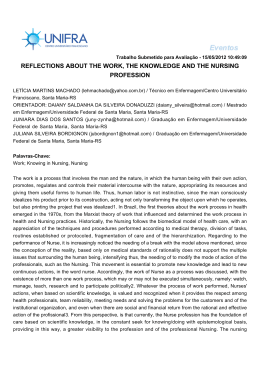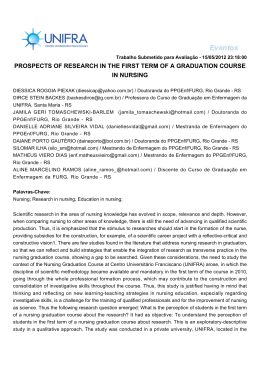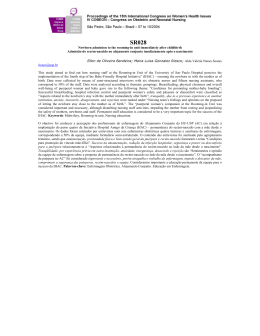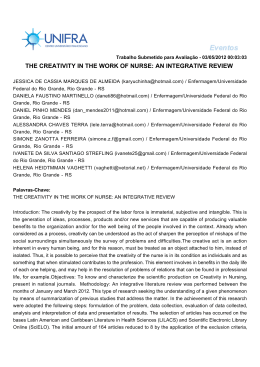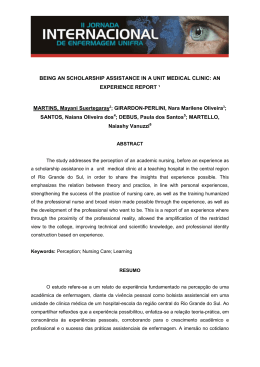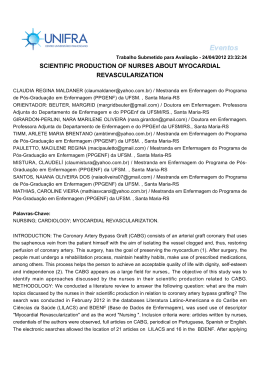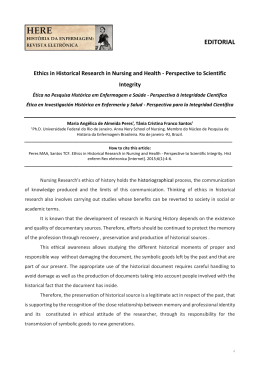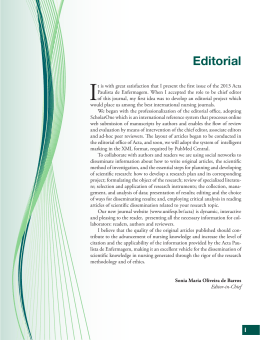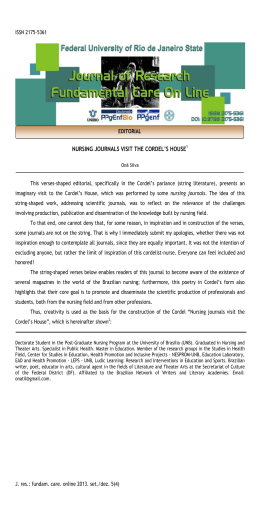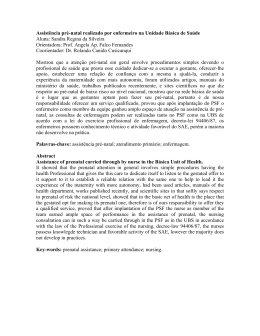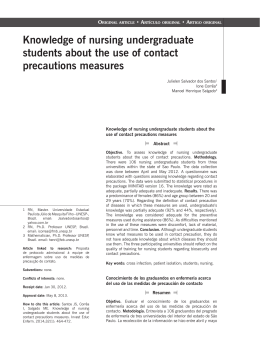Journal of Nursing and Socioenvironmental Health 2014, 1(2):159-162 - http://www.jonse.com.br Received: 25 July, 2014 - Accepted: 12 November, 2014 DOI: 10.15696/2358-9884/jonse.v1n2p159-162 Realistic simulation as a teaching-learning method in the undergraduate nursing level: An experience report Realistic simulation in the undergraduate nursing level Glaucia Dal Omo Nicola1, Daniela Faustino Gonçalves Martinello2, Silomar Ilha3, Danielle Adriane Silveira Vidal4, Nalú Pereira da Costa Kerber5, Bárbara Tarouco da Silva6 ABSTRACT The objective was to describe the activities of an extension project targeted to the application of realistic simulation in the nursing course of a federal university from the extreme south of the state. This activity occurred in the first half of 2012 through a discipline concerning Women’s Health, and the scenario represented a home visit to a puerperal woman. The human resources were students of the Graduate Level who were previously trained by a drama teacher and by the teachers responsible for the project in such a way as to convince the pupils at the time of the practice of realistic simulation. The graduate students developed a clinical case to be executed by undergraduate students, who, throughout the activity, conducted interviews, physical examinations and guidelines to puerperal women, thereby corresponding to the previously designed Actions Protocol. We conclude that realistic simulation is a feasible activity in every university and that integration of graduate students with nursing students extends the knowledge by means of socialization of experiences. Descriptors: Simulation; Undergraduate Nursing Programs; Teaching Materials; Nursing Simulação realística como método de ensino-aprendizagem na graduação em enfermagem: Um relato de experiência Simulação realística na graduação em enfermagem RESUMO Objetivou-se descrever as atividades de um projeto voltado a aplicação da simulação realística no curso de enfermagem de uma universidade federal do sul do Brasil. Essa atividade ocorreu no primeiro semestre de 2012, na disciplina de Saúde da Mulher e o cenário representou uma visita domiciliar puerperal. Os recursos humanos foram estudantes da Pós-Graduação que foram previamente capacitados por um professor de teatro e pelos docentes responsáveis pelo projeto, de forma a convencer os alunos no momento da prática da simulação realística. Os pós-graduandos elaboraram um caso clínico para ser executado pelos graduandos, que no decorrer da atividade, realizaram entrevista, exame físico e orientações à puérpera, correspondendo ao Protocolo de Ações previamente elaborado. Conclui-se que a simulação realística é uma atividade viável a qualquer universidade e que a integração dos pós-graduandos com os acadêmicos de enfermagem amplia o conhecimento por meio da socialização de experiências. Descritores: Simulação; Programas de Graduação em Enfermagem; Materiais de Ensino; Enfermagem Enfermeira. Mestre em Enfermagem. Enfermeira do Hospital Santa Casa do Rio Grande. E-mail: [email protected] Rua: São Borja, 510, bairro: Cassino. Rio Grande (RS), Brasil 2 Enfermeira. Mestre em Enfermagem pelo programa de Pós-Graduação em Enfermagem (PPGEnf), Universidade Federal do Rio grande (FURG). Rio Grande (RS), Brasil. E-mail: [email protected] 3 Enfermeiro. Mestre em Enfermagem, Doutorando em Enfermagem, Programa de Pós-Graduação em Enfermagem (PPGEnf), Universidade Federal do Rio Grande (FURG). Bolsista CAPES. E-mail: [email protected] 4 Enfermeira. Mestre em Enfermagem. Docente do curso de graduação em enfermagem da faculdade Anhanguera. Rio Grande (RS), Brasil. E-mail: [email protected] 5 Enfermeira. Doutora em Enfermagem. Docente da Escola de Enfermagem (EEnf), Universidade Federal do Rio Grande (FURG). Rio Grande (RS), Brasil. E-mail: [email protected] 6 Enfermeira. Doutora em Enfermagem. Docente da da Escola de Enfermagem (EEnf), Universidade Federal do Rio Grande (FURG). Rio Grande (RS), Brasil. E-mail: [email protected] 1 Realistic simulation as a teaching-learning method in the undergraduate nursing level: An experience report Introduction The connection between nursing and simulation is historical, and there are signals of this relationship since the beginning of the XX century, when dummies were developed to represent the care process for the human being. Despite the big initial distance between the simulated and the actual environment, this teaching format was popularized and included in the academic curricula worldwide, and is widely used until the current days1. Researchers and teachers in the field of health realized the need to improve these teaching techniques by presenting new theories for their applicability and driving to the learning through a more reliable and realistic viewpoint. Thus, the reconstructed and updated simulation had its traditional concept reformulated, thereby being recognized as a set of techniques developed with the purpose of recreating, in a substitutive and broad way, an labor and therapeutic space that allows the participation of apprentices2. The implementation of nursing care requires that nurses make decisions, thereby allocating resources and defining strategies. The identification of problems and needs of individuals, families and collectivity and their possible solutions emerge from the judgments and choices of nurses. Thus, one can consider that the practice of nursing care is permeated by decisionmaking processes1. Due to conducting actions targeted to a human object, one should understand that nurses and other health professionals need to avoid, as far as possible, the occurrence of procedural errors. Accordingly, a realistic simulation allows academic students to practice their performance previously, with the possibility of occurrence of failures, and, through discussion, reformulate their behavior successfully3. Realistic simulation may contribute for the acquisition of a more confident stance of on the part of future nurses, who will make decisions in a planned form for the benefit of individuals and families4. Thus, this approach complements the teaching-learning process, since it causes satisfaction in students, who will test their knowledge in advance, and in teachers, who may check the progress and the effectiveness of their expository-dialogued classes, as well as the development of clinical reasoning. The applicability of realistic simulation is evident in some high-tech learning environments, such as 160 the Realistic Simulation Center of the Albert Einstein Hospital, where simulators, dummies and actors are included in a structure called “virtual-hospital”. When entering this environment, the students witness the moments of hospital stay of the patients by contacting them and all related social context in several problemsituations5. By considering the reality and the inherent characteristics to the public university environment, we developed a project that envisages the applicability of realistic simulation in this context. This project was titled “The realistic simulation designed as enhancer for the undergraduate nursing teaching and as prevention of retention and disapproval” and has the objective of enhancing the theoretical and methodological foundations of the undergraduate nursing teaching with a focus on decision-making of academic students in situations of practice in different health contexts6. This experience report has the objective of describing the activities of an extension project targeted to the application of realistic simulation in the nursing course of a federal university from the extreme south of the state. Methods This is an experience report of the activities developed during the first half of 2012 by teachers and students of a graduate nursing course of a federal university from the extreme south of Rio Grande de Sul. In order to enable students to develop the activity, some workshops were performed in April 2012, which were taught by a drama teacher and by teachers responsible for the project. These workshops approached the importance of concentration and creativity during dramatization in such a way as to convince the students at the time of the practice of realistic simulation. The content addressed in the experience emerged from the discipline “Nursing Care course in Women’s Health”, which belongs to the curriculum of the pedagogical project of the nursing course at the Nursing School from the same university. This is taught in fourth grade and approaches, among other things, the promotion, prevention and recovery of women’s health, from conception to climacteric. The material resources used were designed by graduate students, who had the help of the university J. Nurs. Socioe. Health, 2014, 1(2):159-162 Nicola GDO, Martinello DFG, Ilha S, Vidal DAS, Kerber NPC, Silva BT through a vast amount of material focused on health education activities. Nonetheless, there was a need to buy some external artifacts in order to ensure greater reliability to the actual event guided by simulation. The realistic scenario facilitates the action of students, who practice communication, the teamwork and the humanistic approach of care7. The selection of theme, the characters, the story and the scenario emerged from the group planning of the graduate course members responsible for the task along with the teacher responsible for discipline. All activity, even this report, was guided by the principles of academic ethics, since the students who were the focus of the action were never exposed to any kind of embarrassment, and that this report does not extract statements resulting from the performed activity, which means complying only with the description/ narrative of the developed process. Contextualizing the decision-making process with approach on women’s health: enhancement of practice The chosen content was “Home Visit to Puerperal Women”, which was conducted by nurses in a context similar to the most prevalent social environment in puerperal women from the region in which the study was developed. In order to complement the physical detailing of puerperal women, some common illnesses were represented, such as nipple-areola fissure and dehiscence in episiotomy. The composition of the plot has provided the interview, the cephalic-caudal physical examination, the conduction of guidelines, some specific nursing procedures, the therapeutic communication, the interpersonal relationship, health education, among other interventions. The contact with reality before practical action has enabled the development of these skills, thereby generating safety for future actions along with patients7. One of the graduate students took the responsibility for the observation by using an “Actions Protocol” previously designed containing aspects that should necessarily be approached by students. Together with other notes, the aforementioned student collected data to subsidize the subsequent discussion. The other group members acted in the problem-situation by using the material resources to represent the puerperal woman at home and the community health agent. J. Nurs. Socioe. Health, 2014, 1(2):159-162 Also formed by participants, the class was divided into groups, where four acted in the simulation by conducting care actions, four observed and made notes, and the others watched the progress and performance of colleagues through a critical gaze. The interest was remarkable in all divisions, since one could realize the most varied reactions in the face of the staging that was being held. The group that directly acted in the work has reached the purpose of the meeting successfully, thereby being inserted into the plot in an active and participatory way, educating for the adaptation to the new family dynamics and providing subsidies to puerperal women in such a way as to make them able to achieve their autonomy, self-care and self-confidence. In addition, group members acted in accordance with the majority of aspects of the protocol of expected actions by performing the activities related to the work process of nursing professionals. Finally, the class was organized, along with the responsible teacher, in a circle in order to hold the debriefing, which is a moment of reflection about the performance in the clinical scenario. Debriefing is an important step of the teaching-learning process, since it provides the questioning of the situation experienced by approaching the strengths and weaknesses occurred with the proposal of improvements in its care plan8. This moment was conducive to the contributions of the other students, the questioning of theoretical aspects, the correlation with reality, the survey of failures, and the suggestion of better behaviors. Aspects of verbal and non-verbal communication, empathy, and questions difficult to be visualized in practice were also observed, where the actors reported their feelings towards the interaction with the students by suggesting more efficient methods. The learning of the Nursing Process, work tool of nursing professionals and important transverse axis of curriculum, requires the development of skills related to decision-making and clinical reasoning in all its steps9. There is a need to decide in relation to priorities during investigation, interview and physical examination, besides defining the nursing diagnosis and planning the care plan, thereby choosing the appropriate interventions for each specific case10. Accordingly, the realistic simulation offered possibility of acting in an environment specially created to develop a clinical scenario, thereby trying to faithfully reproduce the practice, with the use of 161 Realistic simulation as a teaching-learning method in the undergraduate nursing level: An experience report actors interpreted by graduate and undergraduate students, and offering the opportunity to exercise the decision-making process. Conclusion The first conduction of realistic simulation was considered positive, both in the perspective of teachers, who find subsidies to address questions of future practical activities, and of students, who find a possibility to train and test their learning by means of this activity. In both parties, the acceptance of the project was evident, since they have expressed interest in performing the activity again. Regarding the non-professional human resources, we have realized that replacement by “actors” nurses poses no risk to the success of the simulation when they are trained. The fact that these professionals have already experienced several actual situations may be considered as a facilitator aspect to a reliable representation, mainly if they participate in the formulation of these characters. The lack of physical resources was supplied by creativity in the achievement of material, coupled with the imagination of all participants of the simulation, which produced an environment with characteristics close to reality. Therefore, one should understand that this activity is feasible in every local reality, and may serve as an auxiliary tool to the teaching of students, regardless of structural conditions. With the development and the increase of research in the area, we hope that the activity of realistic simulation is explored in various realities and problemsituations, so that the practice is enhanced and, consequently, appreciated in the Brazilian curriculum structures. Besides boosting the learning process of academic students, the simulation stimulates their decision-making in the different scenarios of its practice, whether in educational, administrative, and health care aspects. 162 Therefore, the integration of graduate students with academic nursing students extends the knowledge by means of socialization of experiences in which the construction of knowledge is reciprocal. This partnership enhances the training process of nurses. Conflicts of Interest “The authors declared that there is no conflict of interest of any nature.” References 1. Vieira RQ; Caverni LMR. Manequim de Simulação Humana no Laboratório de Enfermagem: uma revisão de literatura. [online]. 2011. Disponível em: http://www.abennacional. org.br/centrodememoria/here/n3vol1artigo7.pdf 2. Gaba D. The future vision of simulation in health care. Quality and Safety in Health Care. 2004; 13(1):2-10. 3. Jeffries PR, Mcneilis AM, Wheeler CA. Simulation as a vehicle for enhancing collaborative practice models. Crit Care Nurs Clin N Am. 2008; 20(5): 471-80. 4. Busanello J, LunardiFilho WD, Kerber NPC, Lunardi VL, Santos SS. Participação da mulher no processo decisório no ciclo gravídico-puerperal: revisão integrativa do cuidado de enfermagem. Rev. Gaúcha Enferm. 2011; 32(4): 807-814. 5. Hospital Albert Einstein. Centro de Simulação Realística. 2011. Disponível em http://www.einstein.br/ensino/ Paginas/centro-de-simulacao-realistica.aspx 6. Kerber NPC, Tarouco B. A simulação realística pensada como qualificadora do ensino da graduação em enfermagem e prevenção da retenção e reprovação. Programa de PósGraduação em Enfermagem. Universidade Federal do Rio Grande, Rio Grande; 2011. 7. Fonseca AS, Janicas RCSV, Porto CA, Moritsugo UM, Sena MH. Criação e implantação do Centro de Simulação Realística do Centro de Aprimoramento Profissional de Enfermagem: relato de experiência. Revista Nursing. 2011; 13(154): 156-160. 8. Fonseca AS. A Simulação Realística no processo ensino aprendizagem em enfermagem. 2011. Disponível em http:// www.nursing.com.br/article.php?a=1214 9. Silveira RCP, Robazzi MLC. Modelos e inovações em laboratórios de ensino em enfermagem. R. Enferm. Cent. O. Min. 2011; 1(4):590-600. 10. SilvaLWS, Nunes ECDA, Souza DM, Charles SS, Luma C. Sistematização da assistência de enfermagem-a práxis no ser-saber-fazer o cuidado. Cogitare Enferm. 2011; 16(3):560-4. J. Nurs. Socioe. Health, 2014, 1(2):159-162
Download
